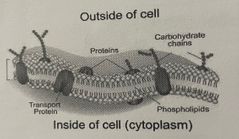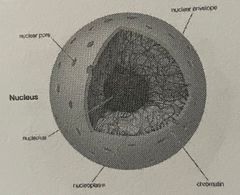![]()
![]()
![]()
Use LEFT and RIGHT arrow keys to navigate between flashcards;
Use UP and DOWN arrow keys to flip the card;
H to show hint;
A reads text to speech;
12 Cards in this Set
- Front
- Back

Cells-surface membrane |
-Made of proteins, phospholipid bilateral and glycoproteins. -Regulates movement of substances in and out of the cell. -Receptor molecules allow for it to respond to chemicals like hormones. -Folded into microvilli to increase surface area for absorption. |
|

Nucleus |
-Contains DNA in the form of chromatin providing the instruction for protein synthesis. -Contains nucleoplasm -Contains nucleolus which coordinates the synthesis of ribosomes with rRNA and proteins. |
|
|
Mitochondria |
-Double membrane bound organelle, inner membrane folded into the cristae that increases surface area. -Contains matrix that contains respiratory enzymes for use in aerobic respiration producing ATP. |
|
|
SER |
-Large network of tubes for the transport and synthesis lipids. |
|
|
Golgi apparatus |
-Flattered membrane sacs which sort, modify and package the proteins/lipids produced by the RER and SER. |
|
|
Lysosomes |
-Membrane sacs/ vesicle produced by the Golgi containing lysozymes (hydrolytic enzyme) that can destroy unwanted structures and pathogens. |
|
|
Ribosomes |
-Made of rRNA and protein used for protein synthesis |
|
|
RER |
-Large network of tubes often connects to the nuclear membrane, each membrane is call a cisternae which is covered in ribosomes for the transport and synthesis of proteins. |
|
|
Cell Wall |
-Made up of cellulose (plants and algae) -Murein (bacteria) and chitin (fungi) -Provide strength and rigidity to the cell and to withstand pressure |
|
|
Vacuole |
-Contains cell sap, a weak solution of sugar and salts can be used for storage and maintain cell shape |
|
|
Chloroplast |
-Double membrane bound organelle, contains stroma site of light dependent reaction -Thylakoid discs stacked into grana contain chlorophyll and is the site of light dependent reaction of photosynthesis |
|
|
Starch grain |
-This is a large store of glucose produced from photosynthesis and doesn’t affect the water potential of the cell. |

